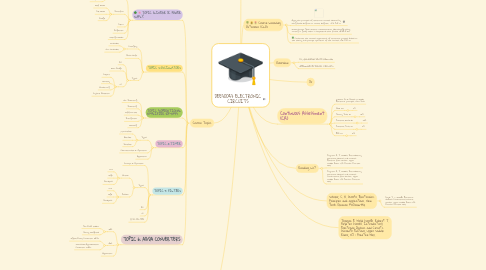
1. Course Topics
1.1. TOPIC 1:LINEAR DC POWER SUPPLY
1.1.1. Transformer
1.1.1.1. Step Up
1.1.1.2. Step down
1.1.2. Rectifier
1.1.2.1. Half Wave
1.1.2.2. Full Wave
1.1.2.3. Bridge
1.1.3. Filter
1.1.4. Regulator
1.1.5. Voltage Divider
1.2. TOPIC 2:OSCILLATORS
1.2.1. Category
1.2.1.1. Sinusoidal
1.2.1.2. Non sinusoidal
1.2.2. Phase shift
1.2.3. Types
1.2.3.1. RC
1.2.3.2. Wein Bridge
1.2.3.3. LC
1.2.3.3.1. Colpitt
1.2.3.3.2. Hartley
1.2.3.3.3. Armstrong
1.2.3.3.4. Crystal Oscillator
1.3. TOPIC 3:OPERATIONAL AMPLIFIER (OP-AMP)
1.3.1. Non Inverting
1.3.2. Inverting
1.3.3. Differential
1.3.4. Integrator
1.3.5. Summing
1.4. TOPIC 4:TIMER
1.4.1. Types
1.4.1.1. Monostable
1.4.1.2. Astable
1.4.1.3. Bistable
1.4.2. Characteristic & Operation
1.4.3. Application
1.5. TOPIC 5: FILTERS
1.5.1. Concept & Operation
1.5.2. Types
1.5.2.1. Active
1.5.2.1.1. Low
1.5.2.1.2. High
1.5.2.1.3. Bandpass
1.5.2.2. Passive
1.5.2.2.1. Low
1.5.2.2.2. High
1.5.2.2.3. Bandpass
1.5.3. RC
1.5.4. LC
1.5.5. ∏ RC FILTER
1.6. TOPIC 6: AD/DA CONVERTERS
1.6.1. DAC
1.6.1.1. The R/2R ladder
1.6.1.2. Binary-Weighted
1.6.2. ADC
1.6.2.1. Digital Ramp Converter (DRC)
1.6.2.2. Successive Approximation Converter (SAC)
1.6.3. Application
2. Exam info
2.1. Structure (80m)
2.1.1. T1(LINEAR DC POWER SUPPLY) & T2(OSCILLATORS)
2.1.2. T4(TIMER)
2.1.3. T5(FILTERS)
2.1.4. T6(AD/DA CONVERTERS)
2.2. Essay (20m)
2.2.1. T3(OPERATIONAL AMPLIFIER (OP-AMP)
3. Program Learning Outcomes (PLO)
3.1. 1. Apply knowledge of applied mathematics, applied science, engineering fundamentals and an engineering specialisation as specified in DK1 to DK4
3.2. 5. Apply appropriate techniques, resources, and modern engineering and IT tools to well-defined engineering problems, with an awareness of the limitations (DK6).
3.3. 10. Communicate effectively on well-defined engineering activities with the engineering community and with society at large, by being able to comprehend the work of others, document their own work, and give and receive clear instructions.
4. Schuler, C. A. (2003). Electronics: Principles and applications. New York: Glencoe McGraw-Hill
4.1. Floyd, T. L. (2008). Electronic devices: Conventional current version. Upper Saddle River, NJ: Pearson Prentice Hall.
5. Thomas E. Hoyd (2008). Robert T. Paynter (2006). Introductory Electronic Devices and Circuits (Seventh Edition), Upper Saddle River, NJ : Prentice Hall.
6. Overview
6.1. PN MAZURAIDA BINTI ABDULLAH
6.2. DEE30043:ELECTRONIC CIRCUITS
7. Continuous Assessment (CA)
7.1. Malvino, A., & Bates, D. (2016). Electronic principles. New York
7.2. Quiz (2)
7.2.1. 5%
7.3. Theory Test (1)
7.3.1. 10%
7.4. Practical Work (6)
7.4.1. 25%
7.5. Practical Test (1)
7.5.1. 5%
7.6. EOC (1)
7.6.1. 15%
